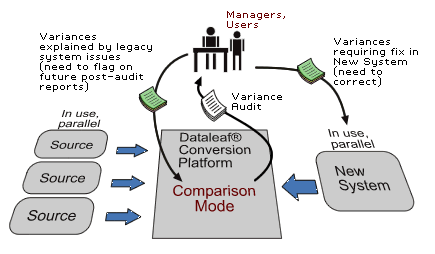
Dataleaf Technologies, Inc: HR System migration, archiving, analysis, modeling, interim HRIS
Dataleaf® Conversion Process (page 4)
[continued from page 3]
Task 4: Post-Audit Support
In most system migration projects, there is a post-audit. That is, there is a period during which old and new systems are both maintained, and -- at some point -- there is a comparison involving the two, to determine if, and in what way, they have diverged after final conversion.
Dataleaf supports an automated post-audit process directly on the DCP; all necessary data structures are already present, and the conversion engine is still in place:

Task 4: Post-Audit Support
There are four snapshots in a post-audit of this sort: (1) Legacy snapshot at conversion; (2) legacy snapshot at post-audit; (3) target snapshot at conversion; and (4) target snapshot at post-audit.
Dataleaf's conversion platform manipulates these four snapshots and provides automated support for investigation all variances found. Variance reports are created.
Some of these variance reports define an agenda for correcting setup or data in the New System. Sometimes the Platform is used to 're-synchronize' problem areas by selective reconversion of legacy system data, before the legacy systems are 'turned off' for good.
A Typical Sequence of Events for Dataleaf® Conversion Platform 'Post-audit Support'
- Final Conversion occurs, populating the new system, but the legacy systems are continued in parallel for a test period. This is usual among almost all HRIS system migrations, even though it means double entry of data for a test period.
- After an interval, the current state of both systems is sampled. Then, along with a stored image of old and new data frozen at the time of final conversion, the result is analyzed. If payrolls are involved, pay events are sampled, as well as database states.
- If the two systems are not running perfectly in parallel (almost inevitable at first!), the Dataleaf® Conversion Platform identifies variances and arithmetically explores possible hypotheses for the variances.
- Several post-audits are often be carried out though the Dataleaf® Conversion Platform.
Benefits of Post-audit via the Dataleaf® Conversion Platform:
- The only reliable way to investigate changes in parallel systems is through the same conversion engine that originally created the new system. The Dataleaf® Conversion Platform provides this support by virtue of its integrated design.
- Once a source of divergence is found and the cause corrected, a small, selective partial reconversion is the best way to 'reset' the two systems. This is trivial under the Dataleaf® Conversion Platform.
- One of the most costly staff-time sinks following any system migration
is parallel testing! The Dataleaf® Conversion Platform greatly
enhances the efficiency of client staff in this area.
Search effort is reduced because the Dataleaf® Conversion Platform does the rough work of identifying all variances at the individual level.
Analytical effort is reduced because -- whenever variances are encountered -- the Dataleaf® Conversion Platform checks for sign-reversal, category, and overtime-related distortions, automatically.
1 2 3 4 Done
- Conversion Process:
- .. page 1
- .. page 2
- .. page 3
- .. page 4
- <- Back to Data Conversion
post-audit features...
Legacy
systems are continued in parallel with their replacement systems for
the duration of a test period.
After an interval, the current state of both systems is sampled. If payrolls
are involved, pay events are sampled, as well as database states.
If the two systems are not running perfectly in parallel (almost inevitable
at first!), the Dataleaf® Conversion Platform identifies variances
and arithmetically explores possible hypotheses for the variances.
